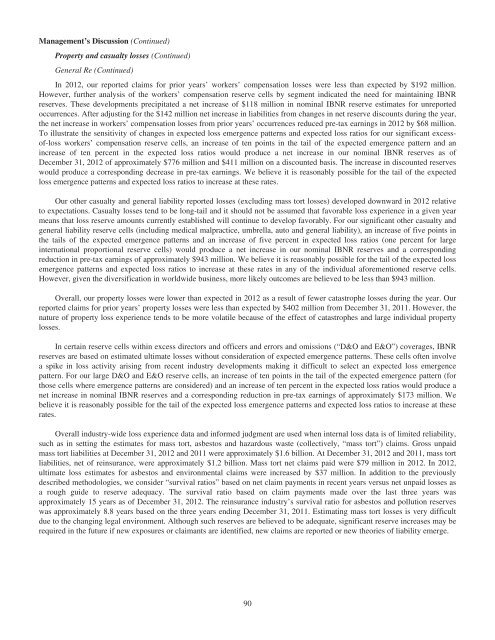BERKSHIRE HATHAWAY
BERKSHIRE HATHAWAY
BERKSHIRE HATHAWAY
Create successful ePaper yourself
Turn your PDF publications into a flip-book with our unique Google optimized e-Paper software.
Management’s Discussion (Continued)<br />
Property and casualty losses (Continued)<br />
General Re (Continued)<br />
In 2012, our reported claims for prior years’ workers’ compensation losses were less than expected by $192 million.<br />
However, further analysis of the workers’ compensation reserve cells by segment indicated the need for maintaining IBNR<br />
reserves. These developments precipitated a net increase of $118 million in nominal IBNR reserve estimates for unreported<br />
occurrences. After adjusting for the $142 million net increase in liabilities from changes in net reserve discounts during the year,<br />
the net increase in workers’ compensation losses from prior years’ occurrences reduced pre-tax earnings in 2012 by $68 million.<br />
To illustrate the sensitivity of changes in expected loss emergence patterns and expected loss ratios for our significant excessof-loss<br />
workers’ compensation reserve cells, an increase of ten points in the tail of the expected emergence pattern and an<br />
increase of ten percent in the expected loss ratios would produce a net increase in our nominal IBNR reserves as of<br />
December 31, 2012 of approximately $776 million and $411 million on a discounted basis. The increase in discounted reserves<br />
would produce a corresponding decrease in pre-tax earnings. We believe it is reasonably possible for the tail of the expected<br />
loss emergence patterns and expected loss ratios to increase at these rates.<br />
Our other casualty and general liability reported losses (excluding mass tort losses) developed downward in 2012 relative<br />
to expectations. Casualty losses tend to be long-tail and it should not be assumed that favorable loss experience in a given year<br />
means that loss reserve amounts currently established will continue to develop favorably. For our significant other casualty and<br />
general liability reserve cells (including medical malpractice, umbrella, auto and general liability), an increase of five points in<br />
the tails of the expected emergence patterns and an increase of five percent in expected loss ratios (one percent for large<br />
international proportional reserve cells) would produce a net increase in our nominal IBNR reserves and a corresponding<br />
reduction in pre-tax earnings of approximately $943 million. We believe it is reasonably possible for the tail of the expected loss<br />
emergence patterns and expected loss ratios to increase at these rates in any of the individual aforementioned reserve cells.<br />
However, given the diversification in worldwide business, more likely outcomes are believed to be less than $943 million.<br />
Overall, our property losses were lower than expected in 2012 as a result of fewer catastrophe losses during the year. Our<br />
reported claims for prior years’ property losses were less than expected by $402 million from December 31, 2011. However, the<br />
nature of property loss experience tends to be more volatile because of the effect of catastrophes and large individual property<br />
losses.<br />
In certain reserve cells within excess directors and officers and errors and omissions (“D&O and E&O”) coverages, IBNR<br />
reserves are based on estimated ultimate losses without consideration of expected emergence patterns. These cells often involve<br />
a spike in loss activity arising from recent industry developments making it difficult to select an expected loss emergence<br />
pattern. For our large D&O and E&O reserve cells, an increase of ten points in the tail of the expected emergence pattern (for<br />
those cells where emergence patterns are considered) and an increase of ten percent in the expected loss ratios would produce a<br />
net increase in nominal IBNR reserves and a corresponding reduction in pre-tax earnings of approximately $173 million. We<br />
believe it is reasonably possible for the tail of the expected loss emergence patterns and expected loss ratios to increase at these<br />
rates.<br />
Overall industry-wide loss experience data and informed judgment are used when internal loss data is of limited reliability,<br />
such as in setting the estimates for mass tort, asbestos and hazardous waste (collectively, “mass tort”) claims. Gross unpaid<br />
mass tort liabilities at December 31, 2012 and 2011 were approximately $1.6 billion. At December 31, 2012 and 2011, mass tort<br />
liabilities, net of reinsurance, were approximately $1.2 billion. Mass tort net claims paid were $79 million in 2012. In 2012,<br />
ultimate loss estimates for asbestos and environmental claims were increased by $37 million. In addition to the previously<br />
described methodologies, we consider “survival ratios” based on net claim payments in recent years versus net unpaid losses as<br />
a rough guide to reserve adequacy. The survival ratio based on claim payments made over the last three years was<br />
approximately 15 years as of December 31, 2012. The reinsurance industry’s survival ratio for asbestos and pollution reserves<br />
was approximately 8.8 years based on the three years ending December 31, 2011. Estimating mass tort losses is very difficult<br />
due to the changing legal environment. Although such reserves are believed to be adequate, significant reserve increases may be<br />
required in the future if new exposures or claimants are identified, new claims are reported or new theories of liability emerge.<br />
90


